Love-in-a-mist is an easy-to-grow annual that provides delicate, lacy foliage and pretty blooms in various colors, including white, pink, blue, and purple. You can enjoy these beautiful flowers in your backyard with a bit of care. Love-in-a-mist is a great way to add color to your planting beds and makes a beautiful cut flower. Love-in-a-mist is easy to grow from seed and makes an excellent addition to any cottage garden or flower border.
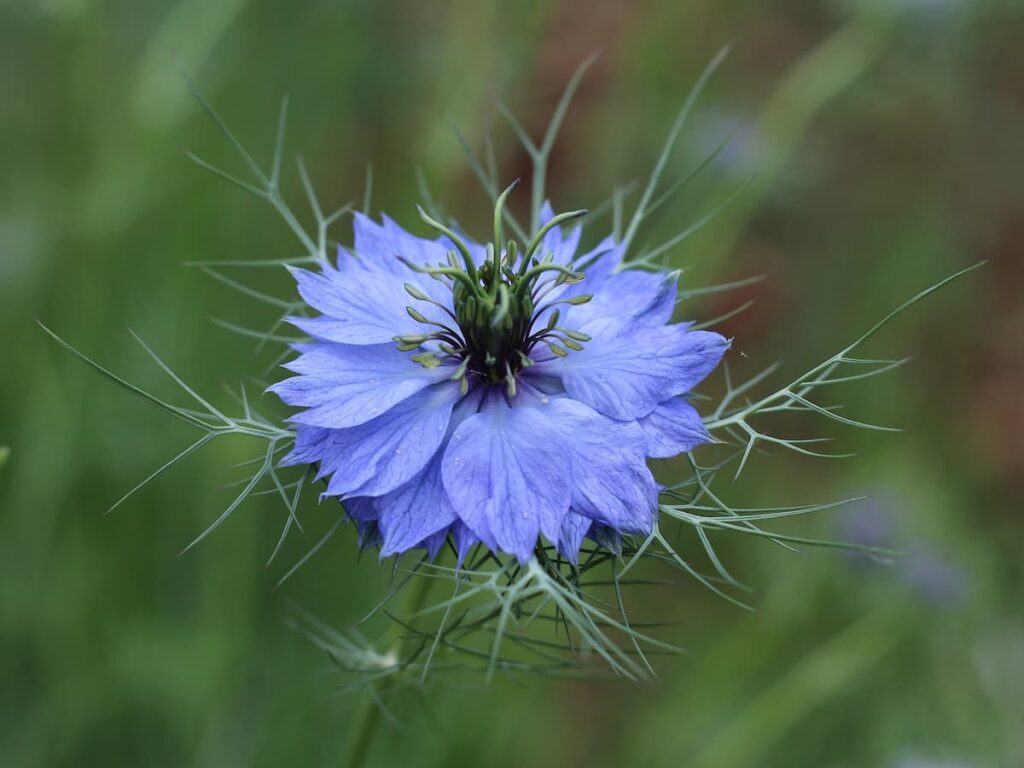
How to grow Love-in-a-mist in your backyard
Types of Love-in-a-mist
- Miss Jekyll – This is a popular and common type with white, blue, and rose flowers.
- Miss Jekyll Alba – It is a double, white-flowered cultivar with bright green seed pods.
- Blue Midget – It is a dwarf variety that is only ten inches long. Suitable for edging.
- Cambridge Blue – It is a long-stemmed variety with double-blue flowers and is perfect for cutting.
When to plant Love-in-a-mist?
The best time to plant Love-in-a-mist is spring after the last frost. You can sow Love-in-a-mist seeds directly into the ground or start indoors in pots. If you’re living in a short-growing season area, you should start seeds indoors about 5 to 7 weeks before the last frost date is best. Sow the seeds on the surface of a soil-less mix and keep them moist but not wet.
Climate requirement for growing Love-in-a-mist in your backyard
Love-in-a-mist is an annual flower that’s easy to grow and maintain. It tolerates a range of climates but grows best in locations with full sun and well-drained soil. Love-in-a-mist can be planted in early spring in a warm climate. Before planting, wait until the last frost has passed in cooler climates. Start with healthy seedlings from a reputable nursery or garden center to ensure your Love-in-a-mist plants have the best chance of success.
Once you have your seedlings, choose a planting site that receives full sun for at least six hours daily. Once you’ve selected the perfect spot for your Love-in-a-mist, prepare the area by removing any weeds or other debris. Love-in-a-mist is native to the Mediterranean region and requires warm temperatures and full sun to thrive. In cooler climates, the plant can be grown as an annual. With proper care, Love-in-a-mist plants can produce an abundance of beautiful blooms from early summer through fall.
In case you missed it: Growing Morning Glory Flowers: How to Plant and Care
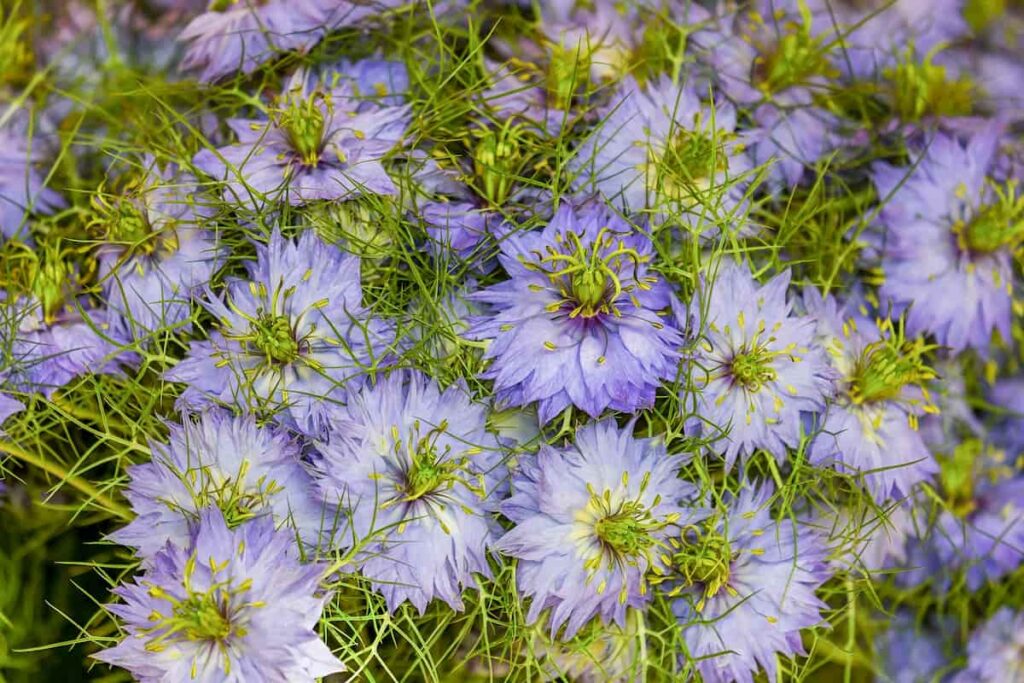
Soil requirement for growing Love-in-a-mist in your backyard
Love-in-a-mist grows best in rich, well-drained soil. If your soil is heavy or clay, consider amending it with compost or other organic matter to help improve drainage. Love-in-a-mist also prefers soil pH between 6.0 and 7.0. To grow Love-in-a-mist in your backyard, you will need soil rich in organic matter and drains well. You will also need to make sure the soil is moist but not wet.
If the soil is too wet, the plant roots will rot. The plant will only absorb enough water if your soil is dry. You’ll need well-drained, rich soil to grow Love-in-a-mist in your backyard. Love-in-a-mist thrives in full sun to partial shade, so choose a spot in your yard that gets six hours of direct sunlight daily. If you live in an area with hot summers, consider planting Love-in-a-mist in a shady spot to protect it from the harsh midday sun.
Water requirement for growing Love-in-a-mist in your backyard
Love-in-a-mist is a fast-growing, annual plant that produces delicate, blue flowers surrounded by lacy foliage. This easy-to-grow flower is perfect for adding texture and interest to any garden. Love-in-a-mist is a drought-tolerant plant, once established. However, it will perform best if given regular water, especially during the hottest months of summer. If your area has low rainfall, consider supplementing with irrigation.
Water is essential for the healthy growth of Love-in-a-mist. The plant prefers moist soil, so be sure to water it regularly. Keep the soil evenly moist. You must water your plant more frequently during hot, dry summer days. You can tell when the plant needs water by checking the leaves; if they start to droop, it’s time to give water to Love-in-a-mist.
Propagation of Love-in-a-mist
From seed
Propagation of Love-in-a-mist is best done by seed. You should sow Love-in-a-mist seeds in late winter or early spring, barely covering them with soil. Love-in-a-mist can also be propagated by division in late summer or early fall. One of the best ways to propagate Love-in-a-mist is from seed. The seeds can be sown indoors in late winter or early spring or outdoors after the last frost. To sow indoors, fill a seed tray or pot with a sterile seed starting mix and press the seeds into the mix.
In case you missed it: List of Flowers to Grow in Summer in India: How to Plant and Care
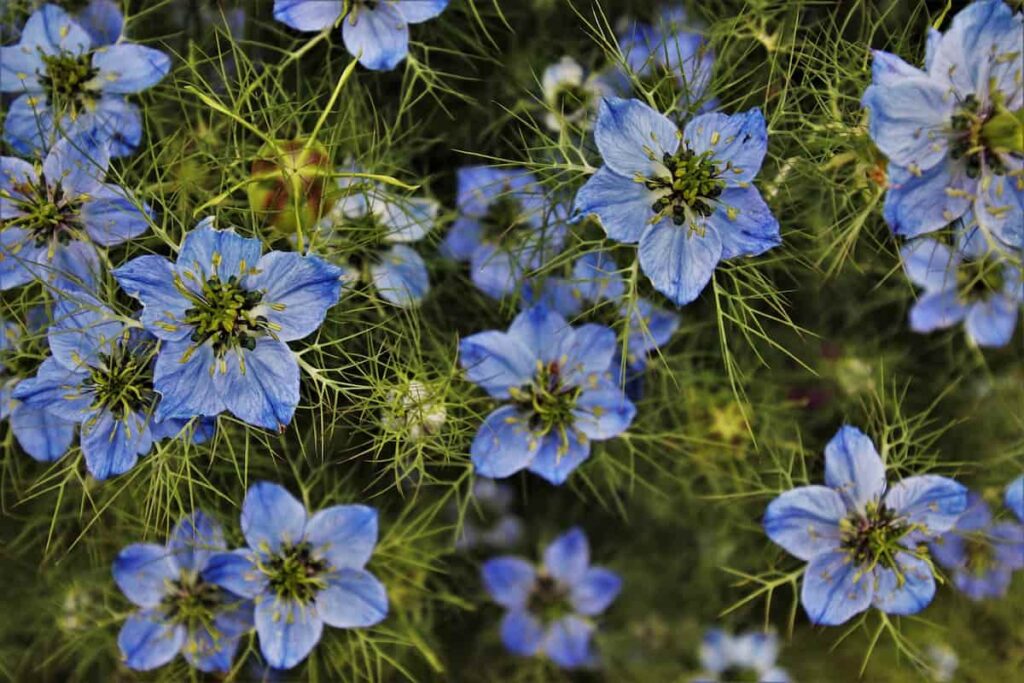
Water lightly and place in a warm, sunny spot. Keep the soil moist but not wet; within a few weeks, the seeds will germinate. Once the seedlings have emerged, they are spaced about 4 inches apart. Keep them watered and fertilized throughout the growing season. Outdoors, you can sow Love-in-a-mist seeds directly into the ground. You should choose a sunny spot with well-drained soil and press the Love-in-a-mist seeds into the ground. Water well and keep an eye on them, thinning out if necessary until they are big enough to handle.
From cuttings
To propagate Love-in-a-mist from cuttings, take softwood or semi-ripe cuttings in late spring or early summer. Cut just below a leaf node with a sharp knife or pruning shears, and remove the bottom leaves. Dip the cutting in the rooting hormone, then plant it in a moist potting mix. Keep the cutting moist but not wet; you should see new growth in a few weeks.
Transplanting Love-in-a-mist seedlings
When transplanting Love-in-a-mist seedlings, handle them with care. These delicate plants can easily be damaged, so it’s essential to be gentle when handling them. The best time to transplant Love-in-a-mist seedlings is spring after the last frost. To prepare for transplanting, you must choose a new pot slightly larger than the current one. Take a new one, fill it with fresh potting mix, and make a small hole in the center.
To transplant, gently remove the seedling from the current pot and place it in the hole in the new pot. Gently backfill around the plant with potting mix and water well. Place the transplanted seedling in a spot that receives partial sun and keep an eye on it for the first few days, watering as needed. Once it has settled into its new home, you can begin enjoying your beautiful Love-in-a-mist plant.
In case you missed it: 16 Best Outdoor Flowering Plants in India: How to Plant, Grow and Care
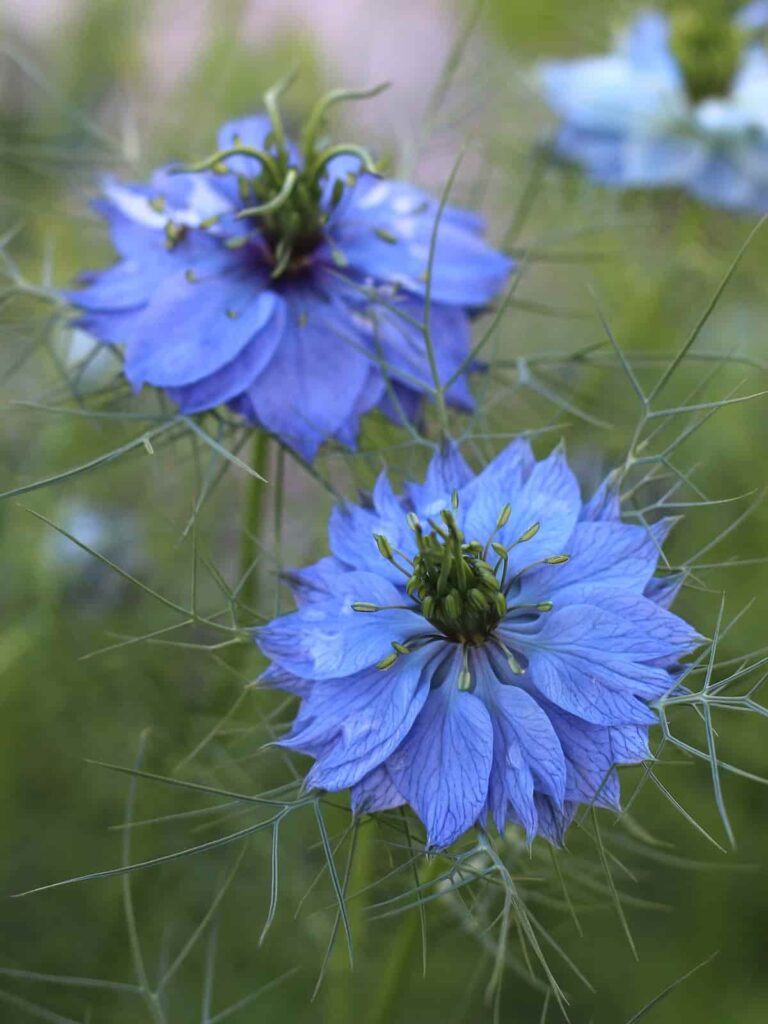
Love-in-a-mist plant care
Fertilizer requirement for growing Love-in-a-mist in your backyard
Fertilizer requirements for growing Love-in-a-mist are not demanding. In general, a balanced fertilizer applied monthly is all that is needed. However, like all plants, Love-in-a-mist will benefit from extra attention during the active growth period in spring and summer. A high nitrogen fertilizer applied every three to four weeks will encourage lush foliage growth.
For best results, apply fertilizer to moist soil and water thoroughly after application. Fertilizer is not required to grow Love-in-a-mist in your backyard, but it will help the plant grow more vigorously. A general-purpose fertilizer such as 10-10-10 or 8-8-8 can be applied at a rate of 113 grams per 100 square feet. Apply the fertilizer in early spring before the plant begins to bloom.
Pruning for Love-in-a-mist
Pruning for love-in-a-mist is a bit different than other types of pruning. You’ll want to wait until the plant is finished blooming before you give it a good trim. Cut back the spent blooms and any seedpods that have formed. Pruning encourages the plant to produce more flowers. Once the plant has stopped blooming, give it a more drastic pruning if needed. Cut back the stems by about one-third to one-half their length. This will help to keep the plant compact and prevent it from getting too leggy.
In case you missed it: How to Grow Flowers in Winter in India: Planting, and Care

Love-in-a-mist care in winter
If you live in an area with harsh winters, you’ll need to take special care of your Love-in-a-mist plants. Move your plants indoors or into a greenhouse before the first frost. Cut back the foliage to about 6 inches to help the plant survive winter. Water sparingly, as too much water can cause the roots to rot. Keep an eye out for pests, such as aphids and whiteflies, which can be a problem indoors. With extra care, your Love-in-a-mist plants will thrive even during the coldest months.
Pests and diseases of Love-in-a-mist and their control
- One of the most common pests of Love-in-a-mist is aphids. These small, soft-bodied insects by sucking the sap from plants, causing them to weaken and eventually die. Aphids can be controlled with insecticidal soap or horticultural oil.
- Another common pest is spider mites. Spider mites spin webs on the undersides of leaves and feed on the plant tissue, eventually causing the leaves to drop off. To control spider mites, spray the plants with water every few days and carefully inspect them for webs. If you see any, remove them by hand or with a sharp spray of water.
- Slugs and snails are also sometimes a problem for Love-in-a-mist. These pests chew holes in leaves and flowers, causing them to wilt and die. To eliminate slugs and snails from your plants, put bait such as beer or eggshells around the perimeter of your garden.
- Powdery mildew causes white or grayish powdery patches on the leaves of infected plants. To control powdery mildew, try applying a fungicide labeled for use against this disease.
- Downy mildew is another fungal disease that can affect Love-in-a-mist. Downy mildew usually appears as yellowish or brownish spots on the leaves of affected plants. To control downy mildew, try applying a fungicide labeled for use against this disease.
- Leaf spot is a fungal or bacterial disease that can cause small, round or irregularly shaped spots on the leaves of infected plants. To control leaf spot disease, try removing and destroying infected leaves and applying a fungicide or bactericide labeled for use against this disease.
- Rust is a fungal disease that can cause orange or reddish-brown spots on the leaves of infected plants. Rust can also cause the leaves of affected plants to turn yellow or brown and drop off prematurely. Try removing and destroying infected leaves and applying fungicides to control rust.
In case you missed it: Cool-season Plants for Pollinators: Vegetables, Flowers, Fruits, Shrubs, and Herbs
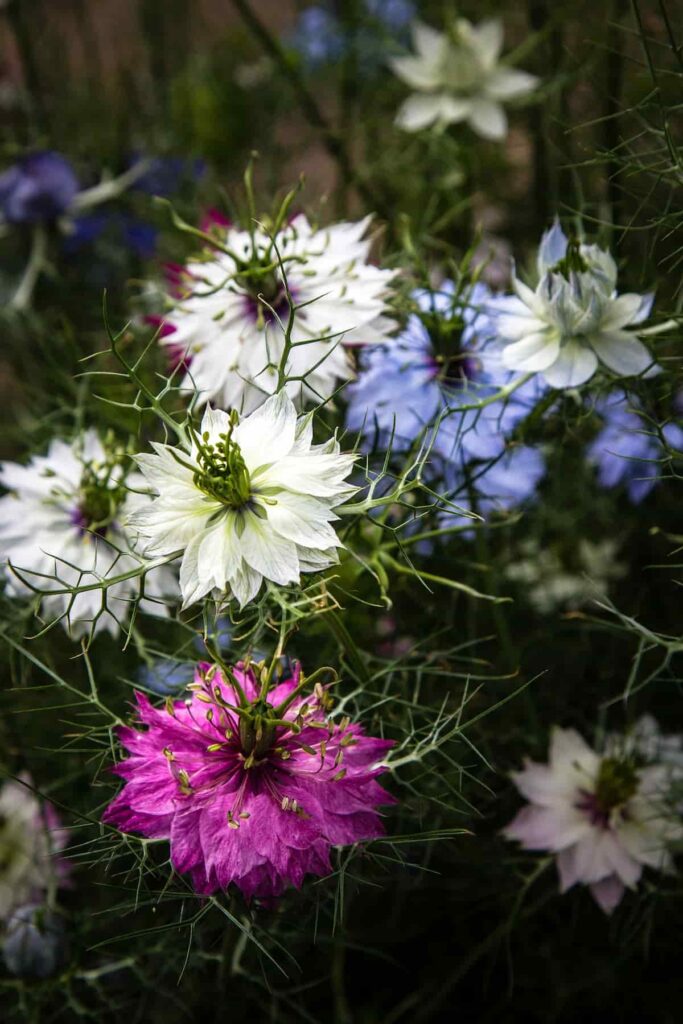
Conclusion
Love-in-a-mist is an annual flower that grows well in most climates. The plant produces blue, pink, or white flowers and can reach 3 feet tall. Love-in-a-mist is a relatively easy plant to grow and makes an excellent addition to any garden. If you follow this article, you should have success in growing this beautiful flower.
- Flower Garden Designs and Layouts for Beginners
- Planting and Spacing Techniques in Papaya: A Beginner’s Guide
- Growing Gold: Essential Techniques for Planting Pineapples
- How to Make Kalanchoe Plant Bushy: Home Remedies and Solutions
- 11 Reasons Why Your Gardenia is Not Blooming: Home Remedies and Solutions
- Eco Elegance: The Guide to Designing a Drought-Tolerant Landscape
- Gardening on a Slope: Strategies for Hillside Landscaping
- Nourish and Flourish: Top Organic Mulches for Thriving House Plants
- Everything You Want to Know about Indian Mogra Flower: Discover Uses and Growing
- Green Thumb Success: Expert Tips for Cultivating Greenhouse Pumpkins All Year Round
- Maximize Growth & Flavor: The Ultimate Guide to Companion Planting in Herb Gardens
- How to Control Rhododendron Problems Naturally: Home Remedies and Organic Ways to Fix Them
- Natural Magic: The Remarkable Benefits of Cinnamon for Plants
- Best Steps to Revive Dying Tulip with Natural and Organic Treatment
- 10 Reasons Why Your Angel Trumpet is Not Blooming: Remedies and Treatment
- How to Fix Periwinkle Leaf and Flower-Related Problems: Natural Remedies and Solutions
- How to Fix Zinnias Leaf and Flower Problems: Discover Natural and Home Remedies
- Organic Steps to Induce Lemon Tree Flowers: A Comprehensive Guide
- Bloom Booster: Crafting the Perfect Homemade Bougainvillea Fertilizer
- Optimizing Growth: A Guide to Applying NPK Fertilizer for Potted Plants
- 10 Best Homemade Fertilizers for Rubber Plant: DIY Recipes and Application Method
- How to Boost Female Pumpkin Flowers: Effective Steps for More Flowers and High Yields
- Transform Your Indoor Garden: Top Benefits of Pink Salt for Houseplants
- 10 Best Homemade Fertilizers for Peacock Plants (Calathea): Easy DIY Guide
- Unlock Blooms: 9 Reasons Why Your Potted Chrysanthemum is Not Blooming
- 8 Reasons Why Your Potted Hibiscus is Not Blooming: Fix it with Simple Solutions
- Unlock Blooms: 9 Key Reasons Your Potted Frangipani Won’t Flower
- 10 Reasons Why Is My Ice Plant Not Blooming: Remedies and Treatment
- 10 Reasons Why My Potted Hydrangea Not Blooming: Treatment and Remedies
- 10 Reasons Why is My Wisteria Not Blooming: Remedies and Treatment
- 10 Reasons Why is My Goldfish Plant Not Blooming: Remedies and Treatment
- Maximize Your Space: Ultimate Guide to Balcony Gardening with Grow Bags
- 10 Reasons Why Your Iris is Not Blooming: Remedies and Treatment
- 10 Reasons Why Your Anthurium Plant is Not Blooming: Treatment and Remedies
- 10 Reasons Why Your Aquaponic Plants Are Not Flowering: Remedies and Treatment
- 10 Reasons Why Your Agapanthus is Not Flowering: Remedies and Treatment